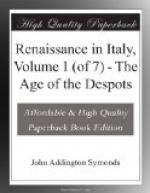Lombards and Franks at Pavia, the incursions of Huns
and Saracens, the kingdom of the Normans at Palermo,
formed but accidents and moments in a national development
which owed important modifications to each successive
episode, but was not finally determined by any of
them. When the Communes emerge into prominence,
shaking off the supremacy of the Greeks in the South,
vindicating their liberties against the Empire in
the North, jealously guarding their independence from
Papal encroachment in the center, they have already
assumed shapes of marked distinctness and bewildering
diversity. Venice, Milan, Genoa, Florence, Bologna,
Siena, Perugia, Amalfi, Lucca, Pisa, to mention only
a few of the more notable, are indiscriminately called
Republics. Yet they differ in their internal
type no less than in external conditions. Each
wears from the first and preserves a physiognomy that
justifies our thinking and speaking of the town as
an incarnate entity. The cities of Italy, down
to the very smallest, bear the attributes of individuals.
The mutual attractions and repulsions that presided
over their growth have given them specific qualities
which they will never lose, which will be reflected
in their architecture, in their customs, in their
language, in their policy, as well as in the institutions
of their government. We think of them involuntarily
as persons, and reserve for them epithets that mark
the permanence of their distinctive characters.
To treat of them collectively is almost impossible.
Each has its own biography, and plays a part of consequence
in the great drama of the nation. Accordingly
the study of Italian politics, Italian literature,
Italian art, is really not the study of one national
genius, but of a whole family of cognate geniuses,
grouped together, conscious of affinity, obeying the
same general conditions, but issuing in markedly divergent
characteristics. Democracies, oligarchies, aristocracies
spring into being by laws of natural selection within
the limits of a single province. Every municipality
has a separate nomenclature for its magistracies,
a somewhat different method of distributing administrative
functions. In one place there is a Doge appointed
for life; in another the government is put into commission
among officers elected for a period of months.
Here we find a Patrician, a Senator, a Tribune; there
Consuls, Rectors, Priors, Ancients, Buonuomini, Conservatori.
At one period and in one city the Podesta seems paramount;
across the border a Captain of the People or a Gonfaloniere
di Giustizia is supreme. Vicars of the Empire,
Exarchs, Catapans, Rectors for the Church, Legates,
Commissaries, succeed each other with dazzling rapidity.
Councils are multiplied and called by names that have
their origin and meaning buried in the dust of archaeology.
Consigli del Popolo, Credenza, Consiglio del Comune,
Senato, Gran Consiglio, Pratiche, Parlamenti, Monti,
Consiglio de’ Savi, Arti, Parte Guelfa, Consigli
di Dieci, di Tre, I Nove, Gli Otto, I Cento—such
are a few of the titles chosen at random from the
constitutional records of different localities.




